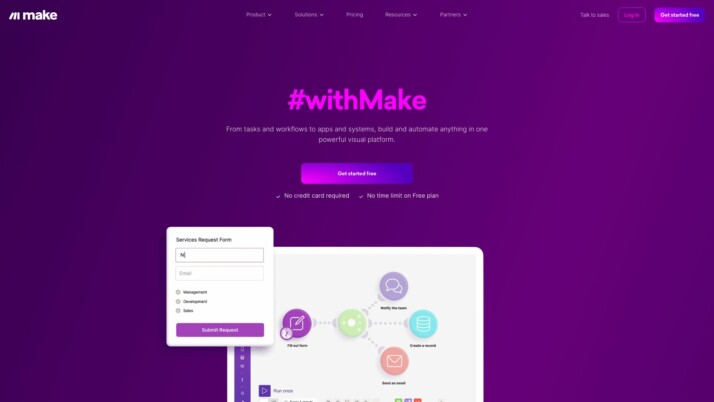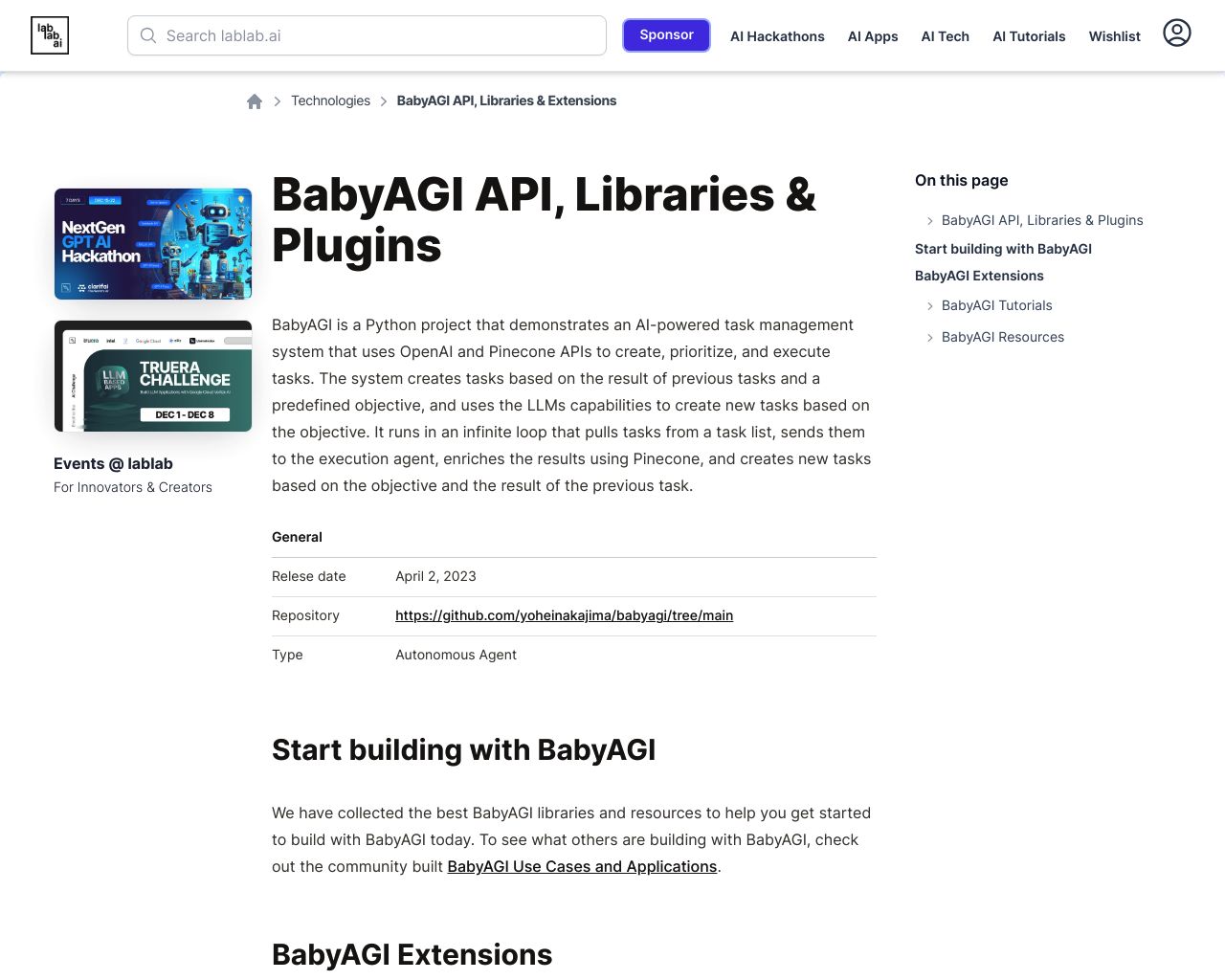Make.com vs. BabyAGI: AI Automation Showdown
AI-powered automation transforms how businesses operate, streamline processes, and manage tasks. This comparison examines Make.com’s visual workflow builder, BabyAGI’s cognitive task management, and SmythOS’s comprehensive AI platform. We’ll explore how each tool tackles automation challenges, their unique features, and their suitability for different business needs. Whether you’re a developer seeking powerful APIs, a business leader focused on scalability, or an entrepreneur looking for user-friendly solutions, this analysis will help you navigate the evolving landscape of AI-driven automation tools.
Make.com Overview
Make.com empowers users to create powerful automated workflows without coding. The platform’s intuitive visual interface allows quick construction of scenarios connecting over 1000 apps and services. Make.com excels at streamlining repetitive tasks, data synchronization, and process automation across diverse business functions.


Make.com’s standout feature is its no-code visual builder. Users drag and drop modules to craft complex workflows, eliminating the need for programming expertise. This accessibility democratizes automation, enabling teams across an organization to boost productivity. The platform’s extensive app integrations cover popular tools like Google Workspace, Slack, and Salesforce, facilitating seamless data flow between systems.
Make.com’s standout feature is its no-code visual builder. Users drag and drop modules to craft complex workflows, eliminating the need for programming expertise.
While Make.com lacks native AI agent capabilities, it compensates with robust workflow automation features. The platform offers granular control over data transformations, conditional logic, and error handling. This flexibility allows users to build sophisticated processes tailored to specific business needs. Make.com’s scheduling capabilities enable automated execution of workflows at predefined intervals, further reducing manual intervention.
Make.com prioritizes collaboration and scalability. The platform supports team-based workflows with role-based access controls, allowing organizations to manage permissions effectively. As businesses grow, Make.com’s tiered pricing model accommodates increased usage and more complex automation needs. However, users should consider potential learning curves when implementing intricate scenarios.
In the competitive landscape of workflow automation tools, Make.com stands out for its balance of power and ease of use. While it may not offer the advanced AI capabilities of some competitors, its robust integration ecosystem and visual approach to automation make it a compelling choice for businesses seeking to optimize their processes without heavy reliance on IT resources.
BabyAGI Overview
BabyAGI revolutionizes task management through open-source artificial intelligence. This innovative platform simulates human-like cognitive processes, enabling autonomous task generation, prioritization, and execution. Developed by Yohei Nakajima, BabyAGI represents a significant step towards achieving artificial general intelligence (AGI).
BabyAGI revolutionizes task management through open-source artificial intelligence. This innovative platform simulates human-like cognitive processes, enabling autonomous task generation, prioritization, and execution.


Unlike traditional AI systems, BabyAGI creates and manages a dynamic list of subtasks based on given objectives. It learns from previous tasks and adapts to new challenges, mimicking human cognitive flexibility. The platform leverages advanced natural language processing capabilities from OpenAI and utilizes vector databases like Pinecone to store and retrieve task results efficiently.
BabyAGI’s standout features include autonomous task generation, efficient prioritization, and integrated memory and learning capabilities. These attributes allow it to improve over time, offering a personalized and adaptive approach to task management. Its task-driven autonomy and adaptability make it suitable for complex problem-solving across various fields, from healthcare to education and creative writing.
BabyAGI creates and manages a dynamic list of subtasks based on given objectives. It learns from previous tasks and adapts to new challenges, mimicking human cognitive flexibility.
However, BabyAGI’s open-source nature may present challenges for users seeking a fully-supported, enterprise-ready solution. While it offers flexibility and customization opportunities, it may require more technical expertise to implement and maintain compared to commercial alternatives. Additionally, as an evolving project, it may lack some of the polished features and integrations found in more established platforms.
Despite these considerations, BabyAGI’s approach to AI, focusing on autonomous task management and human-like learning, positions it as a valuable tool in the ongoing development of artificial general intelligence. Its ability to adapt, learn, and prioritize tasks autonomously offers a glimpse into the future of intelligent automation, making it an intriguing option for developers and researchers pushing the boundaries of AI technology.
Feature Comparison
Make.com and BabyAGI offer contrasting approaches to automation and task management. Make.com excels in workflow automation with its visual no-code builder and extensive app integrations. However, it lacks native AI agent capabilities and autonomous task generation. BabyAGI, on the other hand, focuses on simulating human-like cognitive processes for dynamic task management using AI.
Make.com provides robust scheduling, data transformation, and error handling features within its workflows. It supports team collaboration and offers detailed execution logs for transparency. In contrast, BabyAGI emphasizes autonomous task generation, prioritization, and execution based on given objectives. BabyAGI leverages advanced natural language processing and vector databases to continuously learn and adapt, mimicking human cognitive flexibility.
Core component gaps exist between the two platforms. Make.com lacks AI agents, memory and context capabilities, and multimodal interactions. BabyAGI, while strong in these areas, does not offer the extensive third-party integrations and visual workflow building tools that Make.com provides. Security features also differ, with Make.com offering data encryption and OAuth support, while BabyAGI’s security measures are less clearly defined in its open-source framework.
Feature Comparison Table
| Make.com | BabyAGI | SmythOS | |
|---|---|---|---|
| CORE FEATURES | |||
| AI Agents | ❌ | ✅ | ✅ |
| Hosted Agents (Dev, Production) | ❌ | ❌ | ✅ |
| Environments (Dev, Production) | ❌ | ❌ | ✅ |
| Visual Builder | ✅ | ❌ | ✅ |
| No-Code Options | ✅ | ❌ | ✅ |
| Memory & Context | ❌ | ✅ | ✅ |
| Autonomous Agents | ❌ | ✅ | ✅ |
| Explainability & Transparency | ❌ | ❌ | ✅ |
| Multimodal | ❌ | ✅ | ✅ |
| Problem-Solving Capabilities | ❌ | ✅ | ✅ |
| Multi-Agent Collaboration | ❌ | ✅ | ✅ |
| Human-AI Interaction | ❌ | ❌ | ✅ |
| Audit Logs for Analytics | ✅ | ❌ | ✅ |
| Agent Work Scheduler | ✅ | ❌ | ✅ |
| Logs & Monitoring | ✅ | ❌ | ✅ |
| SECURITY | |||
| Constrained Alignment | ❌ | ❌ | ✅ |
| Data Encryption | ❌ | ✅ | ✅ |
| IP Control | ❌ | ❌ | ✅ |
| COMPONENTS | |||
| Foundation AIs | ❌ | ❌ | ✅ |
| Huggingface AIs | ❌ | ✅ | ✅ |
| Zapier APIs | ❌ | ✅ | ✅ |
| Classifiers | ❌ | ✅ | ✅ |
| Data Lakes | ❌ | ❌ | ✅ |
| DEPLOYMENT OPTIONS (EMBODIMENTS) | |||
| Deploy as API | ❌ | ✅ | ✅ |
| Staging Domains | ❌ | ❌ | ✅ |
| Production Domains | ❌ | ❌ | ✅ |
| Deploy as Site Chat | ❌ | ✅ | ✅ |
| Deploy as Scheduled Agent | ✅ | ❌ | ✅ |
| DATA LAKE SUPPORT | |||
| Hosted Vector Database | ❌ | ✅ | ✅ |
| Sitemap Crawler | ❌ | ❌ | ✅ |
| YouTube Transcript Crawler | ❌ | ❌ | ✅ |
| URL Crawler | ❌ | ✅ | ✅ |
| PDF Support | ❌ | ✅ | ✅ |
| Word File Support | ❌ | ✅ | ✅ |
| TXT File Support | ❌ | ✅ | ✅ |
Best Alternative to Make.com and BabyAGI
SmythOS emerges as the superior alternative to Make.com and BabyAGI, offering a comprehensive AI agent development and deployment platform. We combine the strengths of both competitors while addressing their limitations, providing users with a powerful, flexible, and user-friendly solution for creating intelligent automation workflows.
Our drag-and-drop interface surpasses Make.com’s visual builder, enabling users to construct complex AI-powered workflows without coding expertise. Unlike Make.com’s limited AI capabilities, SmythOS integrates advanced AI models and supports autonomous agents, bridging the gap between traditional automation and cutting-edge artificial intelligence.
SmythOS integrates advanced AI models and supports autonomous agents, bridging the gap between traditional automation and cutting-edge artificial intelligence.
While BabyAGI excels in simulating human-like cognitive processes, SmythOS takes this concept further by offering a complete ecosystem for AI agent development. We provide hosted environments for both development and production, ensuring seamless scalability and deployment options that BabyAGI lacks. Our platform supports multimodal interactions, problem-solving capabilities, and multi-agent collaboration, enhancing the versatility and power of AI solutions.
SmythOS distinguishes itself with robust security features, including data encryption and OAuth support, addressing the limitations of both Make.com and BabyAGI in this critical area. We also offer extensive integration capabilities, supporting various AI models, APIs, and data sources, making it easier for users to incorporate AI agents into existing workflows and systems.
By choosing SmythOS, users gain access to a comprehensive suite of tools for AI agent development, deployment, and management. Our platform combines ease of use with advanced capabilities, empowering businesses and developers to create sophisticated AI solutions that drive innovation and efficiency across industries.
Conclusion
Make.com and BabyAGI offer distinct approaches to automation and task management, each with unique strengths. Make.com excels in visual workflow automation, providing an intuitive no-code platform for connecting diverse apps and services. Its extensive integration ecosystem and team collaboration features make it a solid choice for businesses seeking to streamline processes without heavy reliance on IT resources.
BabyAGI, on the other hand, pushes the boundaries of AI with its focus on autonomous task management and human-like learning. Its ability to generate, prioritize, and execute tasks dynamically showcases the potential of artificial general intelligence. While powerful, BabyAGI’s open-source nature may require more technical expertise to implement effectively.
However, SmythOS emerges as the superior option, combining the best of both worlds and offering additional cutting-edge features. Our platform provides a user-friendly visual builder like Make.com, but enhances it with advanced AI capabilities, including autonomous agents and multi-agent collaboration. Unlike BabyAGI, SmythOS offers a fully-supported, enterprise-ready solution with robust security measures and scalability.
SmythOS stands out with its ’Create Once, Deploy Anywhere’ philosophy, allowing seamless integration across various platforms and services. Our extensive integration ecosystem, support for multiple AI models, and advanced features like multimodal interactions and problem-solving capabilities position SmythOS as the most versatile and powerful option for businesses looking to harness the full potential of AI automation.
Explore our diverse range of AI-powered agent templates to kickstart your journey with SmythOS. Whether you’re a developer, business leader, or AI enthusiast, our platform offers the tools and flexibility to create sophisticated AI solutions tailored to your needs. Get started with SmythOS today and experience the future of AI-powered automation.
Last updated:
Disclaimer: The information presented in this article is for general informational purposes only and is provided as is. While we strive to keep the content up-to-date and accurate, we make no representations or warranties of any kind, express or implied, about the completeness, accuracy, reliability, suitability, or availability of the information contained in this article.
Any reliance you place on such information is strictly at your own risk. We reserve the right to make additions, deletions, or modifications to the contents of this article at any time without prior notice.
In no event will we be liable for any loss or damage including without limitation, indirect or consequential loss or damage, or any loss or damage whatsoever arising from loss of data, profits, or any other loss not specified herein arising out of, or in connection with, the use of this article.
Despite our best efforts, this article may contain oversights, errors, or omissions. If you notice any inaccuracies or have concerns about the content, please report them through our content feedback form. Your input helps us maintain the quality and reliability of our information.
